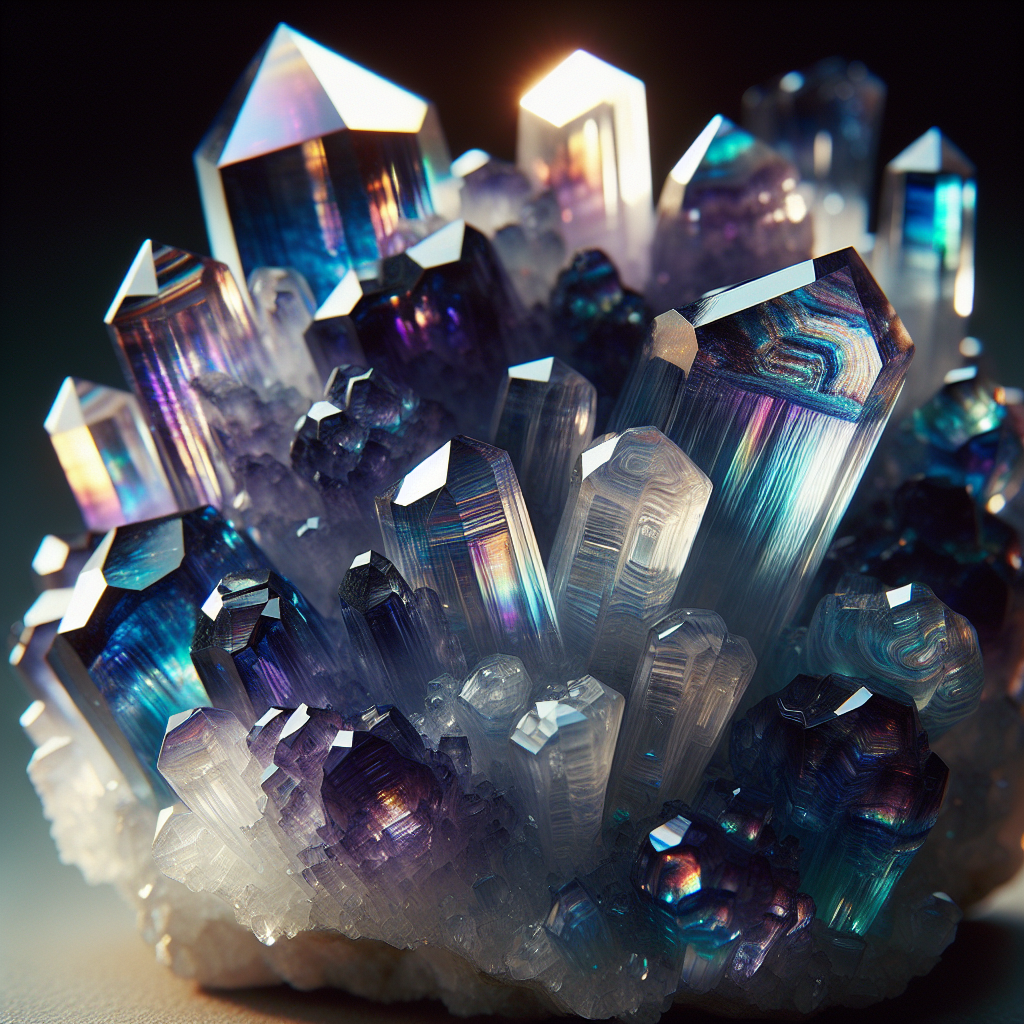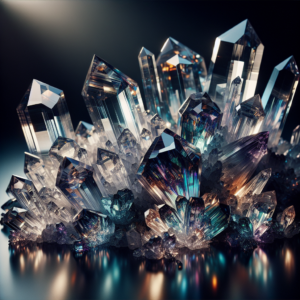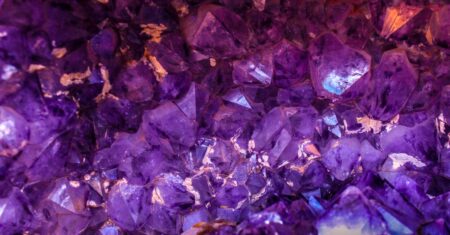
“Unearthing the Mystique: A Deep Dive into the World’s Rarest Crystals”
The world of mineralogy is a treasure trove of beauty, mystery, and scientific intrigue, with crystals and gemstones that captivate both the eye and the imagination. Among these natural marvels, there exists a category so rare and unique that they stand apart, not only for their exquisite beauty but also for the fascinating conditions under which they form. This article aims to explore some of the world’s rarest crystals, delving into their origins, characteristics, and the extraordinary circumstances of their formation.
### Painite
Once considered the rarest mineral in the world, Painite is a borate mineral that was first discovered in Myanmar in the 1950s. For decades, only a few specimens were known to exist, making it an object of intense interest and study among mineralogists. Painite is characterized by its hexagonal crystal structure and its unusual orange-red to brownish-red color. The rarity of Painite can be attributed to its very specific formation conditions, requiring a unique combination of high pressure, temperature, and the presence of certain elements like zirconium, boron, and aluminum.
### Taaffeite
Taaffeite is another exceptionally rare gemstone, distinguished by its striking colors that range from bluish violet to pale rose. Unlike most gemstones that are first identified in their rough state and then cut, Taaffeite was initially discovered already cut and mistaken for spinel. This remarkable discovery underscores not only the rarity of the gemstone but also the challenges in distinguishing it from more common minerals. Taaffeite’s rarity is due to its specific geological formation conditions, which involve the metamorphic processes that transform limestone into marble, a setting where beryllium can become concentrated enough to form this exquisite crystal.
### Red Beryl
Red Beryl, also known as bixbite, is a mineral that is both rare and striking in appearance, with a vibrant red color that rivals that of the finest rubies. What makes Red Beryl particularly rare is its highly specific geological formation conditions. It forms in rhyolitic volcanic flows, where beryllium-rich vapors crystalize under high temperatures and pressures. The rarity of Red Beryl is such that it is found in only a few locations in the world, primarily in the state of Utah, USA.
### Benitoite
California’s official state gem, Benitoite, is a rare blue barium titanium silicate mineral that is found in only a handful of locations worldwide, with the most significant deposits located in San Benito County, California. The crystal is best known for its sapphire-blue color and its unique crystal formation, which resembles that of a diamond. The conditions for Benitoite’s formation are highly specific, requiring a serpentine substrate and hydrothermal activity, factors that contribute to its rarity.
### Grandidierite
Grandidierite is a blue-green mineral first discovered in Madagascar and is considered one of the rarest crystals on Earth. It is prized for its remarkable trichroism, displaying blue, green, and white colors depending on the angle of view. The mineral’s rarity is attributed to its unique composition and the specific conditions required for its formation, involving the metamorphosis of sedimentary rocks under the influence of boron-rich fluids.
### Conclusion
The rarity of these crystals adds to their mystique and allure, making them highly sought after by collectors and enthusiasts worldwide. Each of these minerals tells a story of extraordinary geological processes and
“Beyond the Ordinary: Exploring the Unique Properties of Rare Crystals”
Rare crystals, often nestled away in the hidden crevices of our planet, possess an array of unique properties that have captivated the human imagination for centuries. These enigmatic formations, beyond their sheer aesthetic appeal, hold the key to understanding various scientific phenomena and have practical applications in technology, healing, and even in the quest for sustainable energy solutions. This article delves into the distinctive characteristics of these rare crystals, shedding light on their formation, physical properties, and the pivotal role they play in advancing scientific knowledge and innovation.
### Formation and Rarity
Rare crystals are formed under specific conditions that involve a combination of high pressure, temperature, and the presence of unique chemical compositions. The rarity of these crystals is often due to the scarcity of these conditions or the locations where they occur. For example, Painite, once considered the rarest mineral on Earth, requires a very specific geochemical environment to form, making its natural occurrence exceedingly rare.
### Unique Physical Properties
The physical properties of rare crystals are as diverse as their appearances. Some exhibit extraordinary hardness, such as diamond, which is renowned for being the hardest known natural material. Others possess unique optical properties; for instance, opal exhibits a play-of-color phenomenon due to the diffraction of light by its internal structure. Additionally, certain rare crystals like alexandrite can change color depending on the lighting conditions, a property known as photochromism.
### Scientific and Technological Applications
Rare crystals are not merely objects of beauty; they are also of great scientific interest and utility. For instance, quartz is widely used in the technology industry for its piezoelectric properties, where it can convert mechanical pressure into an electrical signal and vice versa. This property is crucial for the functioning of watches, radios, and various electronic devices.
Moreover, crystals like bismuth telluride hold promise in the field of thermoelectrics, offering a sustainable way to convert temperature differences into electrical energy. This has potential applications in power generation and refrigeration, presenting an eco-friendly alternative to traditional methods.
### Healing and Metaphysical Properties
Beyond their scientific applications, rare crystals are also revered for their purported healing and metaphysical properties. While these claims are often met with skepticism from the scientific community, many cultures around the world have a long history of using crystals in spiritual practices. For example, amethyst is believed to promote clarity of mind and emotional balance, whereas citrine is associated with attracting wealth and abundance.
### Challenges and Conservation
The extraction of rare crystals poses significant challenges, both technically and ethically. Mining operations can lead to environmental degradation and pose risks to local communities. Furthermore, the rarity of these materials often leads to exploitation and illegal trade. As such, there is a growing movement towards ethical sourcing and the conservation of mineralogical sites to ensure that the beauty and diversity of rare crystals can be preserved for future generations.
### Conclusion
Rare crystals offer a fascinating window into the complex and dynamic processes that shape our planet. Beyond their inherent beauty, these materials have profound scientific, technological, and cultural significance. As we continue to explore and understand the unique properties of rare crystals, it is crucial to balance our pursuit of knowledge and innovation with the imperative to preserve and protect these natural treasures.
“Gems of the Earth: Discovering the Most Coveted Rare Crystals”
Gems of the Earth: Discovering the Most Coveted Rare Crystals
Throughout history, the allure of gemstones has captivated humans, symbolizing wealth, power, and beauty. These natural wonders, formed over millions of years under the Earth’s crust, are not only aesthetically pleasing but also carry immense scientific and cultural significance. Among the vast array of gemstones, there exists a select group of rare crystals that are highly sought after by collectors, jewelers, and connoisseurs alike. This discourse aims to illuminate the characteristics, formation processes, and unique aspects of these coveted rare crystals.
### Painite
Once considered the rarest mineral on Earth, painite was discovered in Myanmar in the 1950s. For decades, only a handful of specimens were known to exist, making it an elusive treasure in the gemological world. Painite is distinguished by its striking bordeaux color and hexagonal crystal structure. It is composed of zirconium, boron, aluminum, and oxygen. The scarcity of this gem is attributed to its highly specific formation conditions, requiring the presence of boron and the absence of silicon, which is quite uncommon in nature.
### Red Beryl
Also known as bixbite, red beryl is another gem that ranks high on the rarity scale. It is found primarily in the Wah Wah Mountains of Utah, USA. This gemstone’s vibrant raspberry-pink to rich red coloration is due to the presence of manganese ions in its crystal structure. Unlike its more common relative, green beryl (emerald), red beryl forms in a unique geological setting of rhyolite volcanic flows, where beryllium-rich vapors crystallize under high temperature and pressure conditions.
### Taaffeite
Discovered accidentally when it was mistaken for a spinel, taaffeite is a gemstone that even seasoned professionals might rarely encounter. Its discovery is attributed to Richard Taaffe, who in 1945 identified the gem as a new mineral species. Taaffeite’s distinguishing feature is its double refractive property, unlike spinel, which is singly refractive. This gem varies in color from mauve to bluish violet and owes its hues to the trace amounts of iron, magnesium, and zinc in its composition. The primary sources of taaffeite include Sri Lanka and Tanzania, contributing to its rarity and desirability among collectors.
### Benitoite
California’s state gemstone, benitoite, was discovered at the beginning of the 20th century near the headwaters of the San Benito River, from which it derives its name. This striking blue gemstone exhibits a sapphire-like color that is intensified under ultraviolet light, where it fluoresces a brilliant chalky blue. Benitoite crystals are typically small, making large faceted stones exceedingly rare. The gem’s rarity is attributed to its singular source and its specific geological formation conditions, being found in hydrothermally altered serpentinite.
### Musgravite
Among the rarest gemstones on Earth, musgravite shares similarities with taaffeite in terms of chemical composition and appearance. Initially discovered in the Musgrave Ranges of Australia, this gemstone has since been found in Greenland, Madagascar, and Sri Lanka, albeit in minuscule quantities. The rarity of musgravite is due to its specific formation environment, requiring high temperatures and pressures akin to those found at the Earth’s mantle-crust boundary.
### Conclusion
“The Hidden Wonders of Nature: A Guide to Rare Crystal Formations”
**The Hidden Wonders of Nature: A Guide to Rare Crystal Formations**
Within the vast expanse of nature’s splendor, the mineral kingdom presents some of the most intricate and awe-inspiring phenomena known to humankind. Among these, rare crystal formations stand out as testament to the Earth’s geological processes and the unique conditions under which these structures emerge. This guide delves into the fascinating world of these hidden wonders, shedding light on their formation, characteristics, and where they can be found.
**
- Bismuth Crystals**
Bismuth, a lesser-known element, crystallizes in a stunningly intricate manner, producing rainbow-hued, stair-step structures that captivate the observer. These formations are a result of a relatively low melting point, which allows for the slow cooling of molten bismuth. This gradual process facilitates the formation of its distinctive hopper crystals, characterized by their geometric, angular shapes and iridescent colors. Laboratories often enhance these natural processes to create larger, more visually striking specimens.
**
- Fulgurites**
Fulgurites, colloquially known as “petrified lightning,” are formed when lightning strikes sandy or siliceous soil, fusing the particles together in a glass-like tube. These rare formations encapsulate the power of lightning within a fragile, natural sculpture. The process occurs over mere seconds, yet it captures a moment of immense natural energy. Fulgurites vary in size and shape, depending on the strength of the lightning strike and the composition of the soil, making each specimen uniquely fascinating.
**
- Ulexite**
Ulexite, often referred to as “TV Rock,” is a mineral that naturally forms fibrous structures capable of transmitting light along their lengths, functioning similarly to fiber optic cables. This property allows for the projection of images from one surface of the crystal onto the other, creating a natural ‘television screen’ effect. These formations are typically found in arid regions where evaporative processes contribute to their development.
**
- Pyrite Suns**
Pyrite suns are disk-shaped mineral formations that occur in narrow, coal seam spaces where the pyrite crystallizes in radial patterns. These formations are a result of the compression and heating of pyrite into thin, disk-like shapes, which then radiate outward in a manner reminiscent of the sun’s rays. While their metallic luster and perfect, radial symmetry may suggest artificial creation, these are entirely natural occurrences, primarily found in coal mines.
**
- Amethyst Geodes**
Amethyst geodes are perhaps among the most visually striking crystal formations. These cavities in volcanic rocks are lined with crystalline quartz in vivid shades of purple. The geodes form when gas bubbles within molten lava become trapped, creating cavities that are later filled with mineral-rich water. Over time, the silica in the water crystallizes into quartz, and the presence of trace amounts of iron gives amethyst its characteristic purple color. These geodes can range from a few inches to several meters in height, making them a spectacular display of nature’s artistry.
**Conclusion**
The Earth’s crust is a treasure trove of mineralogical wonders, with rare crystal formations offering a glimpse into the dynamic processes that shape our planet. From the rainbow hues of bismuth crystals to the natural ‘television screens’ of ulexite, these formations embody the beauty and complexity of the natural world. Exploring these hidden wonders not only enhances
“Rare Crystals: Unveiling Their Hidden Powers and Mystical Significance”
Rare crystals, with their enigmatic allure and captivating beauty, have long been subjects of fascination and reverence. Embedded within these natural wonders are stories of ancient wisdom, healing properties, and mystical significance that have been passed down through generations. This document endeavors to illuminate the hidden powers and mystical significance of these rare crystals in a comprehensive and scholarly manner.
### Geological Marvels and Rarity
Rare crystals are formed under unique geological conditions, often requiring thousands, if not millions, of years to develop. The rarity of these crystals is attributed not only to their unique formation processes but also to the specific environmental conditions needed for their creation. Factors such as temperature, pressure, and the presence of certain minerals play a crucial role in the development of these rare gems. Examples of such rarities include Painite, Benitoite, and Red Beryl, each with its own unique set of conditions for formation.
### Healing Properties
For centuries, rare crystals have been revered for their purported healing properties. Cultures around the world have utilized them in practices aimed at physical, emotional, and spiritual healing. For instance, Amethyst is believed to promote clarity and calmness, making it a popular choice for those seeking to reduce anxiety and mental clutter. Similarly, Moldavite, a rare green tektite, is often associated with transformation and is thought to accelerate spiritual evolution. While scientific evidence supporting these claims is limited, the anecdotal experiences of individuals and practitioners continue to sustain the legacy of crystals as powerful tools for healing.
### Mystical Significance
The mystical significance of rare crystals is deeply intertwined with human history and spirituality. Many civilizations, including the Ancient Egyptians, Greeks, and Romans, have incorporated crystals into their rituals, adornments, and even burial practices, attributing to them powers of protection and enlightenment. Crystals like Lapis Lazuli, for example, were cherished by the Egyptians for their ability to connect the physical and divine realms.
In contemporary times, rare crystals are integral to various spiritual practices. They are used in meditation, chakra balancing, and energy work, serving as conduits for the flow of universal energy and aiding in the attainment of higher states of consciousness. The belief in the metaphysical properties of crystals transcends cultures, pointing to a universal human inclination towards the mysteries of the natural world.
### Scientific Perspective
From a scientific standpoint, the fascination with rare crystals extends beyond their metaphysical connotations. The study of these crystals contributes significantly to our understanding of earth sciences and mineralogy. Their unique structures and properties offer insights into the geological processes that shape our planet. Moreover, certain crystals have practical applications in technology; for example, Quartz is used in watches and other electronic devices due to its piezoelectric properties.
### Conclusion
Rare crystals captivate the human imagination, offering a blend of beauty, mystery, and potential healing and spiritual benefits. While the scientific community continues to explore the tangible aspects of these gems, their mystical and healing properties remain a matter of personal belief and experience. Regardless of one’s stance, the allure of rare crystals is undeniable, embodying the magnificence of the natural world and its ability to inspire awe and wonder.





















